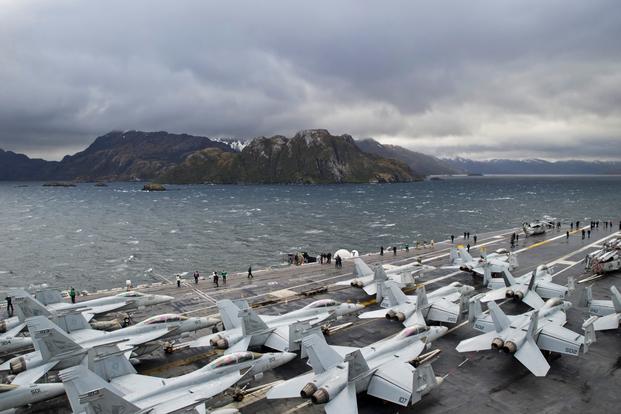Longer deployments and the high pace of operations have taken their toll on the U.S. aircraft carrier fleet, reducing the number currently at sea to five and leaving the Mideast without a carrier on station for the first time since 2007, Navy officials said Tuesday.
"The Navy is operating at a deficit" when it comes to carriers, Sean J. Stackley, assistant Navy secretary for research, development, and acquisition, said at a hearing of the House Armed Services Committee's Seapower Subcommittee.
The official requirement is for the Navy to have an 11-carrier fleet, but the reality is that the service has been operating with 10 since the retirement of the Enterprise in 2013.
The Navy has been "extending carrier deployment lengths," Stackley said.
Vice Adm. John C. Aquilino, the vice chief of naval operations, plans and strategy, said the service "severely overused the carrier force" from 2011 through 2013 driven by the need to maintain a presence in both the Mideast and the Pacific.
"That has put us in place where we're a little bit behind the power curve," he added. "What we're trying to do now is to reset in stride."
As a result, carriers require lengthier stays in port for repairs and maintenance, Stackley said. The net effect has been "a degradation to the Navy's ability to provide the balanced presence and surge capacity," he said.
Currently, four of the Navy's 10 carriers are in "deep maintenance" and a fifth, the USS George Washington, was headed back from South America for repairs, Stackley said. The result is that there are now "five carriers then that are carrying on the operating cycle," he said.
Stackley and the three admirals who joined him in testifying said there was little hope in the Navy getting back up to 11 carriers before 2021, when the USS Gerald R. Ford is finally scheduled to come on line after lengthy construction delays and cost overruns.
"There's no doubt that being at 10 carriers ... is exacerbated by the fact that the Ford won't be now deployable until '21," said Rear Admiral Thomas Moore, program executive officer for aircraft carriers. "The law says, you have to be 11 carriers, but it's only measured by when we commission Ford ... We'll be in a period of 10 carriers here until about 2021."
Rep. Randy Wittman, R-Virginia, the subcommmittee's chairman, summed up the Navy's carrier dilemma: "The reality is that the U.S. Congress and U.S. Navy have agreed that we need 11 carriers and we have less than that today. Not having that (11th) carrier creates a huge vulnerability."
The vulnerability is most evident in the Persian Gulf area, which falls under U.S. Central Command. "We currently are experiencing what the CentCom commander would call a gap," Aquilino said.
Last month, the carrier Theodore Roosevelt and its strike group – the destroyers Farragut, Sherman and Churchill (DDG 81), and the Ticonderoga-class guided-missile cruiser Normandy, left CentCom's and the Navy's 5th Fleet area of responsibility in the Mideast. It was the first time since 2007 that the Mideast has been without a carrier strike group on station.
The carrier Eisenhower had been scheduled to replace the Roosevelt, but the Eisenhower needed another 10 months at Norfolk Naval Shipyard for maintenance.
Instead, the Norfolk-based carrier Truman -- originally slated to deploy next summer -- was ordered to ramp up its training and maintenance schedule so it could deploy in the Eisenhower's place. It was unclear when the Truman would eventually deploy.
Note: This story was updated to correct quotes attributed to Vice Adm. John C. Aquilino.
--Richard Sisk can be reachedat Richard.Sisk@military.com.





























